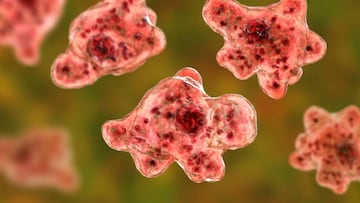What is the brain-eating amoeba found in Iowa? Is it deadly? Symptoms and treatment
A rare life-threatening infection of the brain claimed the life of a person from Missouri after recently swimming in a popular recreational lake in Iowa.

Summer time is when people seek out watering holes across the United States to find some relief from the rising temperatures. Unfortunately, prolonged periods of heat provide the ideal conditions for a particular amoeba, single-celled living organism, commonly found in freshwater and soil around the world called Naegleria fowleri.
Although extremely rare, should it enter a person’s nose and get into the brain it has proven fatal, killing nearly all of those known to have been infected. Recently, a Missouri resident visiting a recreational area in Iowa fell victim to an infection with Naegleria fowleri after swimming in the Lake of Three Fires. Here’s what is known about the rare life-threatening infection of the brain with the amoeba.
Also see:
Infections are incredibly rare from Naegleria fowleri
Naegleria fowleri, although commonly present in the soil and warm freshwater including rivers, lakes, hot springs and even tap water, infections are quite rare. According to the CDC there have been only 31 reported cases of infection between 2012 and 2021 in the US. People are much more likely to drown, for example its estimated that nationally nearly 4,000 people died each year from unintentional drowning between 2010 and 2019.
Infections typically occur in the summer months from July to September and are more likely to occur in southern-tier states. However, the single-celled organism is present around the world and infections can occur in more northern states. Prolonged periods of heat resulting in higher water temperatures increase the probability of infections.
How does the brain-eating amoeba infect people?
In order for the amoeba to access the brain, it must enter through the nose, drinking tap water contaminated with Naegleria fowleri does not result in infection. The organism needs to get to the upper reaches of the nose from people submerging in a contaminated source generally by swimming or diving in a recreational water spot.
On rare occasions, two of the 31 reported cases, people who have cleaned their noses during religious practices or irrigated their sinuses with contaminated tap water got infected. One case happened when the person was infected by contaminated tap water used on a backyard slip-n-slide.
NEWS: We have confirmed a rare brain infection in a Missourian caused by an ameba called Naegleria fowleri. The infection is known as primary amebic meningoencephalitis (PAM) - it is not contagious, but can be life threatening. The patient is being treated in ICU.
— Missouri Department of Health & Senior Services (@HealthyLivingMo) July 7, 2022
🧵 pic.twitter.com/diSioKi96D
Naegleria fowleri is extremely fatal with few treatments
Of the known 154 cases of people getting infected in the United States from 1962 to 2021 with Naegleria fowleri, only four have survived giving the organism a 97 percent fatality rate. Laboratory testing has found several effective drugs against the amoeba but their effectiveness when used in patients has not been proven.
Naegleria fowleri, when it reaches the brain, causes the disease primary amebic meningoencephalitis (PAM), whose symptoms are similar to those of bacterial meningitis in the early stages. The organism normally feeds on bacteria, but absent that eats brain tissue and begins to release toxic molecules that along with the immune system’s attempts to fight off the invader cause the brain to swell which unchecked leads to death.
Doctors were able to save the lives of two people who were recently infected with the amoeba in 2013 and 2016. Both were treated with an experimental drug miltefosine in combination with other drugs and aggressive management of brain swelling by lowering their body temperatures to near freezing.
What are the symptoms of Naegleria fowleri infection
Related stories
Those who get infected by the brain-eating amoeba tend to show symptoms within 5 days of infection but they can begin as early as one day or not appear for up to 12 days. Initial symptoms may include sharp headache in the forehead, fever, nausea, or vomiting.
This can be followed by a stiff neck, altered mental status including confusion, lack of attention to people and surroundings, loss of balance, seizures, hallucinations and coma according to the CDC. The disease can progress rapidly with death usually occurring within five days of infection.


